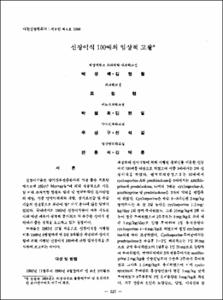KUMEL Repository
1. Journal Papers (연구논문)
1. School of Medicine (의과대학)
Dept. of Internal Medicine (내과학)
신장이식 100예의 임상적 고찰
- Keimyung Author(s)
- Park, Sung Bae; Kim, Hyun Chul; Cho, Won Hyun; Park, Choal Hee; Kim, Chun Il; Woo, Seong Ku; Zeon, Seok Kil; Jeon, Dong Seok; Kim, Jae Ryong
- Department
- Dept. of Internal Medicine (내과학)
Dept. of Surgery (외과학)
Dept. of Urology (비뇨의학)
Dept. of Radiology (영상의학)
Dept. of Laboratory Medicine (진단검사의학)
- Journal Title
- 대한신장학회지
- Issued Date
- 1990
- Volume
- 9
- Issue
- 4
- Abstract
- The 100 cases of living-donor renal transplantation experience at the Keimyung University Hospital between November 1982 and August 1989 was reviewed. The overall 1 and 3 year patient survival rates were 95. 5% and 92.1%, and the corresponding graft survival rates were 89.6% and 79% respectively. Acute rejection occurred in 34 cases. According to HLA match, acute rejection occurred in 8.3% of HLA-identical group, in 31. 3% of haploidentical, and in 57.9% of mismatched/ unrelated groups. Reversibility was 100% in HLA identical group, 90.5% in haploidentical, and 83.3% in mismatched/unrelated group. There were eight deaths, and the causes of death were pneumonia in 2, heart failure in 2, sudden death in 2, bowel infarction in 1, and intracerebral hemorrhage in 1. The 18 patients lost their grafts because of chronic rejection in 7’ acute rejection in 3, renal artery thrombosis in 2’ recurrent glomerulonephritis in 1 and death with functioning grafts in 5. Surgical complications was found in 22 cases, among surgical compications there were 11 perirenal hematoma, 4 transient hydronephrosis, 2 ureteral obstruction, 2 lymphocele, 2 renal artery thrombosis, and 1 kidney fracture. Among the infectious complications, bacterial and viral infections were the most common organisms occuring in 57.4% and 31.5%, respectively, urinary tract infection was the most common cause of bacterial infections. In the non-infectious complications, the most frequent were hyperkalemia (25%), hyperten-sion(20%),erythrocytosis(9%), diabetes mellitus(6%), avascular necrosis of femoral head(5%)t and acute tubular necrosis(3%). The most common side effects of cyclosporine-A were tremor and hirsutism in 63.8%, nephrotoxicity 13.8%, diarrhea 6,4% and gum hypertrophy 4.3% of the patients.
- Alternative Title
- Clinical Experience in 100 Living-Donor Renal Transplantation
- Publisher
- School of Medicine
- Citation
- 박성배 et al. (1990). 신장이식 100예의 임상적 고찰. 대한신장학회지, 9(4), 527–535.
- Type
- Article
- ISSN
- 1225-0015
- Appears in Collections:
- 1. School of Medicine (의과대학) > Dept. of Internal Medicine (내과학)
1. School of Medicine (의과대학) > Dept. of Laboratory Medicine (진단검사의학)
1. School of Medicine (의과대학) > Dept. of Radiology (영상의학)
1. School of Medicine (의과대학) > Dept. of Surgery (외과학)
1. School of Medicine (의과대학) > Dept. of Urology (비뇨의학)
- 파일 목록
-
-
Download
 oak-bbb-02471.pdf
기타 데이터 / 477.28 kB / Adobe PDF
oak-bbb-02471.pdf
기타 데이터 / 477.28 kB / Adobe PDF
-
Items in Repository are protected by copyright, with all rights reserved, unless otherwise indicated.